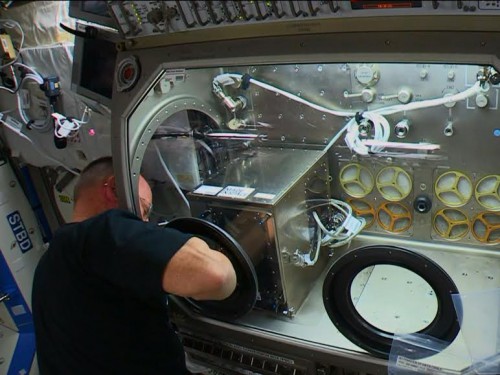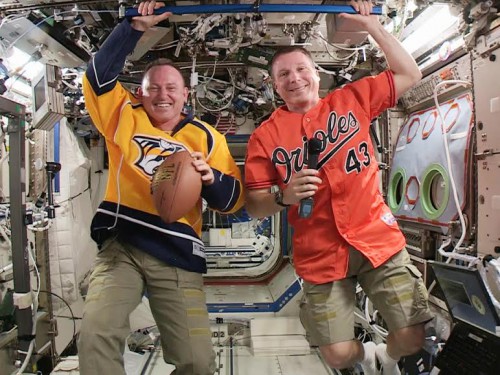
SPACE STATION WEEKLY UPDATE Nov. 24 – Nov. 30, 2014 — Last week on the International Space Station (ISS) the crew count grew by three after new crew members Anton Shkaplerov of the Russian Federal Space Agency (Roscosmos), NASA astronaut Terry Virts, and European Space Agency (ESA) astronaut Samantha Cristoforetti arrived to join astronaut Barry “Butch” Wilmore and cosmonauts Elena Serova and Alexander Samokutyaev for Expedition 42. Their week started with a day of rest on Monday before getting to work with business as usual doing research and maintenance, as well as the unloading cargo from the Soyuz.
Barry “Butch” Wilmore was busy working on preparation and installation of the first 3-D printer in space. The printer will operate and manufacture items as part of the 3-D Printing in Zero-G Technology Demonstration, which aims to show that a vast array of parts and tools can be created in space through additive manufacturing—a step toward operating without supplies sent from Earth.

Wilmore worked to install the printer in the Microgravity Science Glovebox on the station—a facility that has a large front window, along with gloves built into them, to contain liquids and particles in microgravity during experiments conducted in the sealed environment created. The Glovebox has been used for over 30 investigations, ranging from material science to life science.
Once the printer was started by Wilmore, it expelled layers on layers of a relatively low-temperature plastic filament to print the first 3-D item in space—a pair of calibration test prints. The prints are nearly the same size as a postage stamp, and they demonstrate to researchers that the printer is working as it should. Establishing an “on-demand machine shop” with the printer is crucial to future ambitions, as it is a beginning step toward supplying deep-space crewed missions with their own means of manufacturing parts in-house.
Wilmore also did further work on the Advanced Colloids Experiment-Microscopy-3 (ACE-M-3) study, preparing a Light Microscopy Module by replacing an objective lens, installing a new target, and installing a new camera. Controllers at NASA’s Payload Operations Integration Center in Huntsville, Ala., began working with the ground team in an effort to start performing checks on the hardware Wilmore installed, as well as beginning to characterize the microscope.
The ACE-M-3 investigation is being conducted to show the relationship between the shape, crystal symmetry, and structure of three-dimensional structures being designed and assembled from small particles suspended within a fluid medium in microgravity. Researchers are hoping to solve problems involving unavoidable heat generation and bandwidth limitations by using the materials these structures are a crucial component of, to create new and improved optical technology.
Also this week, the Magnetic Flux Experiment (MAGVECTOR) was conducted in the European Drawer Rack (EDR) for a second time, and the results are being examined by the ground team. MAGVECTOR is a study on the interaction between a moving magnetic field and an electrical conductor.

The Earth’s magnetic field serves many purposes while it constantly surrounds us. It protects us from solar winds, makes a compass operate properly, and gives birds the means to navigate during their annual migrations. It can also get in the way of the functioning of equipment and experiments on the ISS. MAGVECTOR will assist researchers in finding out how the magnetic field influences conductors, and give them insight into how to prevent its interference on the ISS in the future.
A somewhat traditional Thanksgiving dinner—adapted for consumption in microgravity—was enjoyed by all crewmembers on the ISS last week. As they orbited 260 miles above Earth, they prepared their meal by opening bags of freeze-dried, irradiated, and thermostabilized foods. Their space cuisine consisted of irradiated smoked turkey, thermostabilized candies yams, freeze-dried green beans, and mushrooms. They also feasted on NASA’s freeze-dried cornbread dressing and thermostabilized cherry-blueberry cobbler for dessert.
The food flown on the ISS is mostly the same as what has been flown in space since the beginning of the Space Shuttle Program over 30 years ago. Meals serve a dual-purpose on the ISS, as they provide nourishment for the residents and a means of researching and developing methods of preparing food to extend shelf-life for deep space missions while minimizing the volume of the packages used for storage. The ISS is also used as a laboratory to facilitate experiments about growing plants in space, such as lettuce.
Thanksgiving meals for crewmembers in the future may include a traditional fresh food item—sweet potatoes—which can handle living in a controlled environment with artificial sunlight. The sweet potato is a versatile and durable food source, and it may be one of the crops chosen for crews to grow on deep space missions as a source of carbohydrates and beta-carotene.
Want to keep up-to-date with all things space? Be sure to “Like” AmericaSpace on Facebook and follow us on Twitter: @AmericaSpace



